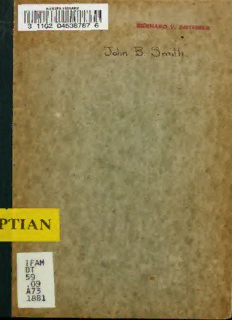
Catalogue of the Egyptian antiquities in the Ashmolean Museum PDF
Preview Catalogue of the Egyptian antiquities in the Ashmolean Museum
NYUIFALIBRARY BEKNARO V. SOTHUeil PTIAN IFAM DT 59 .09 A73 1881 : BERNARD V. BOTHMei» CATALOGUE / OF THE EGYPTIAN ANTIQUITIES IN THE ASHMOLEAN MUSEUM, OXFORD. BY GREVILLE CHESTER, B.A. OxoN. J. OXFORD PARKER AND CO. BROAD-STREET. l88l. PREFACE. THE EgyptianAntiquities in the Ashmolean Collection of the University of Oxford are, for greater conve- nience of reference and study, arranged in this Catalogue — in three Sections the Civile the Religious^ and the Sepul- chral; and every object, with the exceptions mentioned below, will be found under one or other ofthese divisions. In the Civil Section will be found the objects which illustrate the daily life and customs of the ancient Egyp- tians, and their useful and decorative arts. In the Religions Division are contained the representa- tions of the deities of the ancient Egyptian Pantheon; the figures of Sacred Animals, and the various Religious Amulets and Emblems to which sacred and symbolical meanings were assigned. Many ofthese last were enjoined by the Ritual ofthe Dead to be placed with the mummied remains of deceased persons, but are, nevertheless, more conveniently enumerated in this rather than in the next succeeding Division. In the SepulchralSection are found the objects ofEgyp- tian art which are connected with the Embalming and Burial ofthe Dead. Objects of the Greek and Roman periods, and of dis- tinctively Christian character, found in Egypt, are placed in Sections oftheir own. A separate List is appended of the Arabic objects con- nected with Egypt, and a brief account of the few Baby- lonian, Assyrian,and PersianAntiquities in the Ashmolean, whether found in Egypt or not, has been added by the Rev. A. H. Sayce, M.A., ofQueen's. iii PREFACE. The thanks of the Compiler are due to Dr.S. Birch, D.C.L., LL.D., for his ready and generous assistance in the decyphering of inscriptions, when his own knowledge failed him; for the aid afforded by the *'Guide to the First and Second Egyptian Rooms"in the BritishMuseum ; and to Mr. Charles T. Catty, of the Liverpool Public Museum, the lines of whose excellent Catalogue of the Mayer Collection have been mainly followed. In describing the objects given by the Christy Trustees, the List has been incorporated which was compiled by A. W. Franks, Esq., F.S.A., ofthe British Museum, whose name will be a guarantee ofits correctness. For the dimensions of the objects enumerated Mr. Ed- ward Evans is responsible. The Compiler hopes that the present Catalogue, under- taken at the request of the Curators and Keeper, will prove of some use in promoting the study of Egyptian Archaeology, and may be the means of inducing Oxford men to aid in making the Collection more worthy of their ancient University. GREVILLE CHESTER, B.A. Oxon. J. MemberoftheRoyalArchcBologicalInstitute. IV — ; NOTE. In order to prevent needless repetition, the names of Donors of numerousobjects aredistinguished in the Catalogue by Initials only asbelow. C. C. Trusteesofthe Christy Collection, 1866—1874. G.J. C. GrevilleJ. Chester, B.A., 1865—1881. P. Purchasedbythe Museum Funds, 1870—1881. O. C. These letters indicateobjects enumeratedinthe Catalogueof1836, H. J. Henderson, M.A., Ball. Coll., by bequest, 1879. Thesizesofthe objectsaregiven thus: S. Size, i.e. lengthandvridth. L. Length. D. Diameter. T. Thickness. LIST OF PLACES IN WHICH OBJECTS IN THE COLLECTION HAVE BEEN FOUND. ABOUSIR, the ancient Busiris, betweenGeezehand Sakkara. ALEXANDRIA. BENHA, or BENHA-EL-ASSAL, i.e. Benha of the Honey, so named from the pot of honeysent hence bythe Copt Makaukas to Mohammed. A modem town close to the site of Athribis, now called K6m-el-Atreeb, andmarkedbythe smallvillage ofAtreeb. DAKKEH ; ancientlyPselcis, or Pselchej a place in Nubiawith the ruins ofa Temple. DAMANHOUR, the capital ofthe Province of Baheyreh. The an- cient Egyptian Tejjia-m-Hor, 'Cityof Horus,' and the Hermopolis Parva ofthe Romans. DRAH-ABU'L-NEGGEH. Anancient cemeteryon theWest bank ofthe NileatThebes. ELEPHANTINE, now called Gezeret Assouan, a small Island im- mediatelybelowthe First Cataract of the Nile, close to the boun- daryofEgypt and Nubia. ERMENT ; ancientlyHermonthis, nearThebes. GEEZEH, a village on the Nile a little above Cairo, whichgives its name to that portion of the Necropolis of Memphis in which are situated the Pyramids of Khufu (Cheops), Khafra (Chefren), and Menkara (Mycerinus). HELOUAN HELWAN or ; a modern village, with sulphureous springs, opposite Bedrashayn; it stands in the desert, which here- abouts abounds withprehistoricimplements ofsilex. KARNAK; a smallvillage and vast Temple, with surroundingruins, onthe Easternbank ofthe Nileat Thebes. MAABDEH. The site of caverns nearthe top of the Gebel Abou- faydeh, opposite Manfalut in UpperEgypt, inwhich are found the mummiedremains ofCrocodiles. MEDINET-EL-FAYOUM, the capital of the Fayoum; anciently Crocodilopolis, or Arsinoe, whose extensive mounds near the city arenownamed Kom Faris. vii EGYPTIAN COLLECTION. MEDINET-HABOU. Ruins ofagreatTemple on theWestbank of the NileatThebes. MEMPHIS ancientlyHa-Ptah,'the HouseofPtah;' andMen-nefer, ; 'good place,' corrupted into Menfi and Memfi; whence Memphis. The moundsof this ancient capital of Egypt are partlyoccupiedby thevillagesofMitraheneh and Sakkara. RAMLEH (Sand), a scattered village of modern hcftises nearAlex- andria, nearlyoccupyingthe site oftheRomanNicopolis. SAN or SAN-EL-HAGAR, San ofthe Stones; ancientlycalledZ&n, Zoan,and Tanis. Cf. Numb.xiii. 22; PsalmIxxviii.; Isaiahxix.11. SHOBT; ancientlyHypsele, in Upper Egypt. TEL-BASTA; anciently/'/-^a^/, Pibezeth. Cf. Ezekiel xxx. 17, and Bubastis; the mounds of the sacred cityof Sekhet, Pasht, or Bast, nearthemodern Zagazig. TEL-EL-YAHOUDEH, or TEL-EL-YAYHOUDEYEH, 'the Mound ofthe Jew;' extensive mounds and ruins near Shebin-el- Kanfi-terinLowerEgypt; the site, perhaps, ofOneias. THEBES; ancientlyApand Ape, orwith the feminine article Tap^e^ theHeadorCapital; theDiospolis (Magna) ofthe Romans. CAIRO, called by the Arab population MasW or Mis'r-el-Kahtra (Mas'rtheVictorious), themodern capital ofEgypt. Inthemounds ofrubbish East ofthe citymuchmediaeval Arabic potteryand other antiquitiesarefound; buttheseare oflaterdatethan thosefoundat Fostat. DAYR BABLl^N, a Coptic convent, near Mas'r-el-Ateykeh, Old Cairo, which retains the name of the adjacent Roman fortress of Babylon. FOSTAT, so calledfromtheleathern TentofAm'r, the Arabiancon- queror, A.D. 638. This citywas the predecessor of Cairo, and its moundsofrubbishcoveravastareabetween thefortressofBabylon and the GebelMokattam.
Description: